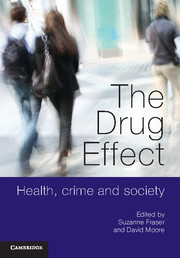Book contents
- Frontmatter
- Contents
- List of contributors
- Acknowledgements
- Introduction
- Part 1 Drug use as social and cultural practice
- Part 2 Drugs, health and the medicalisation of addiction
- 5 Beyond the ‘potsherd’
- 6 Drugs that work
- 7 From ‘magic bullets’ to medical maintenance
- 8 Pharmacotherapy as social policy, or, the public and private worlds of welfare capitalism
- Part 3 Drugs, crime and the law
- Index
- References
5 - Beyond the ‘potsherd’
The role of injecting drug use-related stigma in shaping hepatitis C
from Part 2 - Drugs, health and the medicalisation of addiction
- Frontmatter
- Contents
- List of contributors
- Acknowledgements
- Introduction
- Part 1 Drug use as social and cultural practice
- Part 2 Drugs, health and the medicalisation of addiction
- 5 Beyond the ‘potsherd’
- 6 Drugs that work
- 7 From ‘magic bullets’ to medical maintenance
- 8 Pharmacotherapy as social policy, or, the public and private worlds of welfare capitalism
- Part 3 Drugs, crime and the law
- Index
- References
Summary
‘Things that gather cannot be thrown at you like objects’.
Latour, ‘Why has critique run out of steam?’Hepatitis C constitutes a major health issue around the world. Despite some important variations, it is possible to trace a pattern in hepatitis C infection. It clusters among the most impoverished, disadvantaged and stigmatised members of almost any population, whether it be a national population in which injecting drug use is vilified or a global population in which some nations are underresourced compared to others. This clustering can be understood in a range of ways. The aim of this chapter is to formulate an approach to disease that is able to acknowledge the ways in which social and political forces, namely poverty, disadvantage and stigma, directly shape the disease hepatitis C. This will not, however, take the form of the fairly commonplace argument that impoverished and disadvantaged people transmit and contract disease more freely than the privileged. An approach of this kind would suggest (at least) two assumptions: (1) that hepatitis C pre-exists the populations in which it manifests, and (2) that such populations should be enjoined to change their ways to reduce the freedom with which this pre-existing disease of hepatitis C moves between bodies. These ideas are insufficiently sophisticated to capture the interrelationship of bodies and viruses and the social in the making of disease. They can also lead to insufficiently careful and effective strategies for responding to particular formulations of the problem of disease.
- Type
- Chapter
- Information
- The Drug EffectHealth, Crime and Society, pp. 91 - 105Publisher: Cambridge University PressPrint publication year: 2011
References
- 7
- Cited by



